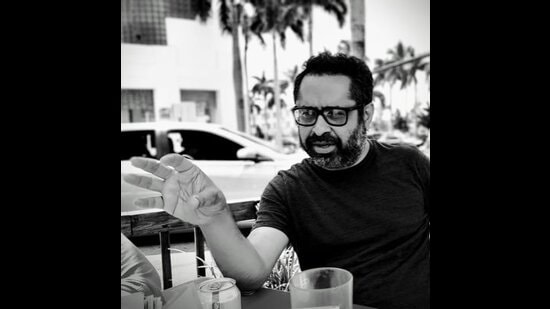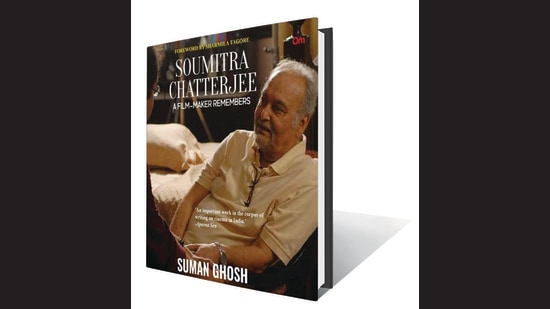Review: Soumitra Chatterjee – A Film-maker Remembers by Suman Ghosh
When a filmmaker embarks on a journey into the past to write a book on a great actor, the challenges for the reviewer are many. The first is getting past the awe with which the author approaches his subject. This is understandable considering the author Suman Ghosh is writing about Soumitra Chatterjee, one of the greatest actors of Indian cinema. The second challenge is to discover if the author has been able to view his subject, who died before this project began, objectively. The third is to figure out if a sentimental nostalgia has permeated the narrative. Thankfully, while the book is deeply emotional, it still presents a well-rounded picture of Soumitra Chatterjee.
As is usually the case when one prominent personality writes about another, the reader is actually reading two books at once – one is about the writer and the other is about his subject. Soumitra Chatterjee – a Film-maker Remembers, which charts the journey of the director with the actor whom he hero-worships to this day, is no different. Divided into nine chapters, it includes many illustrations, photographs and even Chatterjee’s translation of the monologue from James Joyce’s The Dead, which was part of Ghosh’s Basu Paribar.
Ghosh first made news with his directorial debut, Podokhhep, which won the National Award for best feature film in Bengali, and also fetched Soumitra Chatterjee the best actor award. In it, Chatterji plays Shasanka Palit, a lonely old man who lives with his unmarried daughter, and is steadily regressing to childhood even as he is haunted by the fear of death. “The film opens with a shocking symbol of death. The strap-hanging Palit inside a moving metro looks out in fear at himself waiting outside on the platform, having failed to catch the train. The Palit inside the moving train is perhaps moving away from life. The Palit on the platform encapsulates the memories and experiences of his life. This scene is repeated when Palit really looks outside the metro train and is shocked to discover a frightened and confused Trisha standing on the platform,” Chatterjee once said in an interview with this writer.
The thespian featured in four other Ghosh films including his second feature Dwando (2009), his third, Nobel Chor (2012, guest appearance), Peace Haven (2015) and Basu Poribar (2019). The director’s oeuvre also includes his fourth film, the eponymous Kadambari, a loosely structured, fictionalised account of Tagore’s relationship with his sister-in-law, a much-appreciated short feature called Shyamal Uncle Turns off the Lights, and a long documentary on Amartya Sen.
Over 13 years of working successfully together, the relationship between Ghosh and Chatterjee transformed from that of a young professional directing a legendary actor to a deeply personal one. Ghosh admits that he looks upon Chatterjee as his mentor, a foster-father from whom he learnt much, not just about films, acting and direction, but also about life and its varied manifestations, including death.
“He was by far the most vibrant person I have met. His lust for life knew no bounds. Whether through literature, through poetry, through films, through his interactions with people, through theatre, it was as if he wanted to perpetually soak in the delirium of life and be bathed in all its beauty. His mind was like a blank canvas, ready to be painted with colours,” writes Ghosh whose book is full of anecdotes.
Especially interesting is the one that details the author’s anxiety about pairing Mithun Chakraborty and Chatterjee in Nobel Chor, even though the latter only had a guest role. Thankfully, the two actors blended into their characters and seamlessly grew into each other as if they were born to do the film together.

The filmmaker, who is also a professor of economics at Florida Atlantic University, explained how he ventured into films: “I was always interested in filmmaking but lacked the technical faculty. I had come to Cornell University to do my doctorate in economics. During my stay there, I decided to pursue film studies from the department of theatre, films and dance. It was all about the theory and art of filmmaking from scratch. I didn’t do a degree course but took all the basic classes for a Masters in film studies. I completed my PhD and took up a job. Then I made a documentary on Amartya Sen, my first film. After that, I had the opportunity to assist Gautam Ghosh for Dekha in Kolkata. I wanted to make my own feature.”

Ghosh’s easy-flowing narrative presents the individual beyond the actor Soumitra Chatterjee’s screen persona. He uncovers the layers of celebritydom to reveal the father, husband and grandfather he was. The reader learns of Chatterjee’s many talents as a poet, writer, theatre person and singer, and about his less publicized talent of painting. We learn too of his role as a raconteur who could keep film crews entertained with jokes during shooting breaks.
While this is a good read, it could have done without the long list of endorsements at the beginning. A director of Ghosh’s calibre does not really need them. Still, this is a book that should find a place on the shelves of everyone interested in film.
Shoma A Chatterji is an independent journalist. She lives in Kolkata.
When a filmmaker embarks on a journey into the past to write a book on a great actor, the challenges for the reviewer are many. The first is getting past the awe with which the author approaches his subject. This is understandable considering the author Suman Ghosh is writing about Soumitra Chatterjee, one of the greatest actors of Indian cinema. The second challenge is to discover if the author has been able to view his subject, who died before this project began, objectively. The third is to figure out if a sentimental nostalgia has permeated the narrative. Thankfully, while the book is deeply emotional, it still presents a well-rounded picture of Soumitra Chatterjee.

As is usually the case when one prominent personality writes about another, the reader is actually reading two books at once – one is about the writer and the other is about his subject. Soumitra Chatterjee – a Film-maker Remembers, which charts the journey of the director with the actor whom he hero-worships to this day, is no different. Divided into nine chapters, it includes many illustrations, photographs and even Chatterjee’s translation of the monologue from James Joyce’s The Dead, which was part of Ghosh’s Basu Paribar.
Ghosh first made news with his directorial debut, Podokhhep, which won the National Award for best feature film in Bengali, and also fetched Soumitra Chatterjee the best actor award. In it, Chatterji plays Shasanka Palit, a lonely old man who lives with his unmarried daughter, and is steadily regressing to childhood even as he is haunted by the fear of death. “The film opens with a shocking symbol of death. The strap-hanging Palit inside a moving metro looks out in fear at himself waiting outside on the platform, having failed to catch the train. The Palit inside the moving train is perhaps moving away from life. The Palit on the platform encapsulates the memories and experiences of his life. This scene is repeated when Palit really looks outside the metro train and is shocked to discover a frightened and confused Trisha standing on the platform,” Chatterjee once said in an interview with this writer.
The thespian featured in four other Ghosh films including his second feature Dwando (2009), his third, Nobel Chor (2012, guest appearance), Peace Haven (2015) and Basu Poribar (2019). The director’s oeuvre also includes his fourth film, the eponymous Kadambari, a loosely structured, fictionalised account of Tagore’s relationship with his sister-in-law, a much-appreciated short feature called Shyamal Uncle Turns off the Lights, and a long documentary on Amartya Sen.
Over 13 years of working successfully together, the relationship between Ghosh and Chatterjee transformed from that of a young professional directing a legendary actor to a deeply personal one. Ghosh admits that he looks upon Chatterjee as his mentor, a foster-father from whom he learnt much, not just about films, acting and direction, but also about life and its varied manifestations, including death.
“He was by far the most vibrant person I have met. His lust for life knew no bounds. Whether through literature, through poetry, through films, through his interactions with people, through theatre, it was as if he wanted to perpetually soak in the delirium of life and be bathed in all its beauty. His mind was like a blank canvas, ready to be painted with colours,” writes Ghosh whose book is full of anecdotes.
Especially interesting is the one that details the author’s anxiety about pairing Mithun Chakraborty and Chatterjee in Nobel Chor, even though the latter only had a guest role. Thankfully, the two actors blended into their characters and seamlessly grew into each other as if they were born to do the film together.

The filmmaker, who is also a professor of economics at Florida Atlantic University, explained how he ventured into films: “I was always interested in filmmaking but lacked the technical faculty. I had come to Cornell University to do my doctorate in economics. During my stay there, I decided to pursue film studies from the department of theatre, films and dance. It was all about the theory and art of filmmaking from scratch. I didn’t do a degree course but took all the basic classes for a Masters in film studies. I completed my PhD and took up a job. Then I made a documentary on Amartya Sen, my first film. After that, I had the opportunity to assist Gautam Ghosh for Dekha in Kolkata. I wanted to make my own feature.”

Ghosh’s easy-flowing narrative presents the individual beyond the actor Soumitra Chatterjee’s screen persona. He uncovers the layers of celebritydom to reveal the father, husband and grandfather he was. The reader learns of Chatterjee’s many talents as a poet, writer, theatre person and singer, and about his less publicized talent of painting. We learn too of his role as a raconteur who could keep film crews entertained with jokes during shooting breaks.
While this is a good read, it could have done without the long list of endorsements at the beginning. A director of Ghosh’s calibre does not really need them. Still, this is a book that should find a place on the shelves of everyone interested in film.
Shoma A Chatterji is an independent journalist. She lives in Kolkata.
